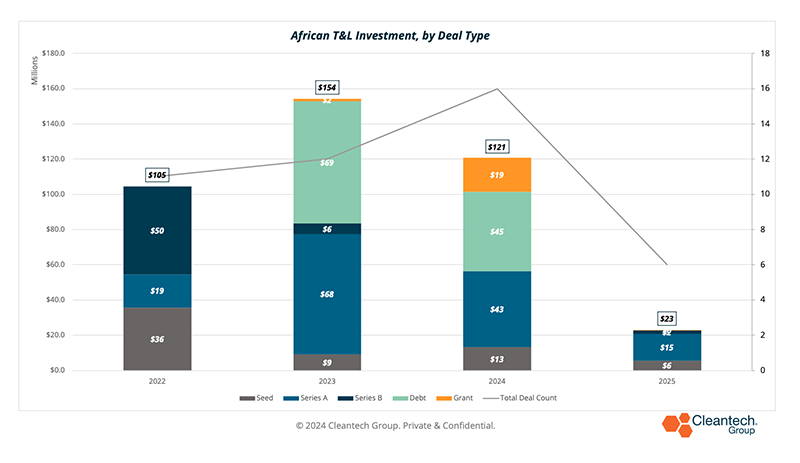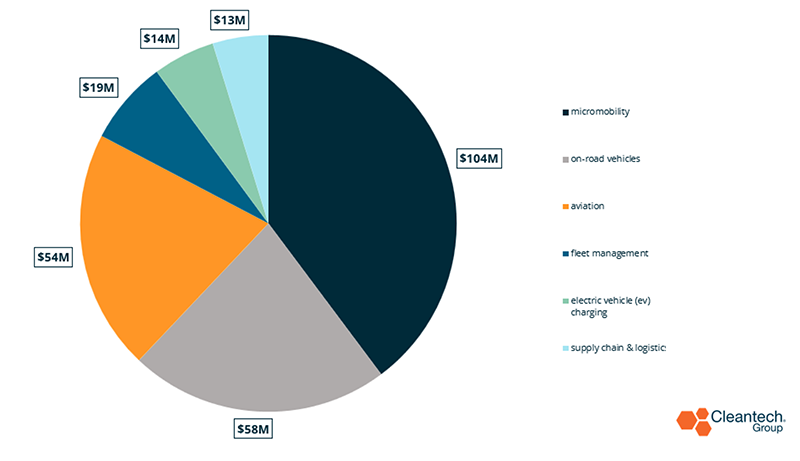The conversation around the decarbonization of transport tends to revolve around the challenges and innovation in the global north: the dynamic between Chinese and “western” auto OEMs, scaling up national and international EV charging networks, EU EV battery legislation, and controversy around robotaxis, to name a few. These market dynamics are essential in grasping the challenges and opportunities in decarbonizing global transport systems.
The erroneous assumption that these market and innovation dynamics are ubiquitous across the globe, however, creates a biased narrative that cleantech ecosystems for transportation are exclusively located in the global north. Cleantech Group H1 2025 investment data showed that the Indian transportation and logistics (T&L) innovator ecosystem was one of the most active in terms of deals (Indian T&L innovators secured more deals than any other sub-sector outside of the U.S.).
Cleantech ecosystems across the global south are deploying innovation and establishing market mechanisms to address both specific local challenges (e.g., high traffic and congestion) and broader international difficulties (e.g., unreliable grid connections). This blog will specifically explore the African transportation and logistics ecosystem, highlighting key demand drivers, ecosystem players, and upcoming innovation*.
Accelerating Market Potential for Transport Electrification
While African countries are responsible for less than 5% of global emissions, their overall emissions are increasing. Transport sector emissions account for nearly one third of the continent’s carbon output. Electrification of heavy- and light-duty vehicles is the most direct way to reduce these emissions.
Similar to India, the African EV market is growing swiftly and is projected to expand from $17.4B in 2025 to $28.3B by 2030, with a CAGR of 10%. The significant market potential and strong demand drivers for sustainable transport solutions are unfortunately hindered by low investment. A frequently-cited report from Shell Ventures estimated that the sub-Saharan Africa EV market will require $3.5B–$8.9B in investments by 2030 to effectively scale and deploy. While the 2025 numbers fall far short of this milestone, national governments are taking on the challenge to bolster local sustainable transport and scale deployment and adoption.
T&L Venture Investment in Africa, 2022-Q2 2025 Sector Breakdown
T&L Venture Investment in Africa, 2022-Q2 2025 by Investment Type

Regional Rev-Up
An influx of supportive public-sector initiatives across the region work to encourage private sector investment, accelerate EV adoption, and promote local development like financial incentives, multilateral financing schemes/partnerships and proposed frameworks promoting EV adoption and local development. Countries in the region look to capitalize on abundant mineral reserves and existing renewable capacity to circumvent associated costs and supply chain dependencies.
Governments across the region are working to address key challenges to EV adoption:
- Unreliable and/or unstable grid infrastructure, power outages, and unreliable electricity supply
_ - Key resource gaps, namely in access to funding and a skilled workforce
_ - Market restrictions like tariffs and competition from international players like China looking to capitalize on the region’s abundant natural resources
Local governments are looking to establish domestic supply and adoption quickly, supporting manufacturing and initiatives that facilitate easy grid integration.
Nigeria
Policies targeting industry-wide reform were spurred on by the adoption of the National Automative Industrial Development Plan (NADIP) to increase local EV production and adoption, targeting 40% adoption and 30% production by 2033.
- Electric Vehicle Transition and Green Mobility Bill, 2025 (SB 856) passed its first senate reading on July 1st. It works to expand local EV production and build out local infrastructure (charging networks, renewable energy integration into building and transport systems)
_ - Regional focus on shifting towards production-based economies have helped clean mobility production – Enugu state and Stallion Motors, for example, recently secured land to convert into an EV/hybrid production facility that will also upskill engineers to address local knowledge gaps
_ - Early-stage support, particularly in R&D, has worked to address technology and knowledge gaps through leveraging academic resources and international partnerships: the StamiNa project, a research collaboration between Swansea University and tertiary institutions in Nigeria and Kenya, works to develop EV battery technology
Innovator Spotlight:
- Possible EVs (and manufacturing arm, NEV Electric): Producer of 2-, 3-, and 4-wheel EVs. NEV Electric became the largest producer of mass transit EV buses this year, and expects to reach $50M in revenue in the next year
Kenya
Like Nigeria, Kenya’s public sector is working rapidly to establish a local EV industry to better support local players like BasiGo and Roam:
- National E-Mobility Policy: Leverages academia and the private sector to facilitate widespread adoption, establishing sales targets and investment criteria, developing a skilled workforce and boosting R&D. It targets 100% EV adoption by 2050 and includes incentives like reduced import duties and excise taxes to make EVs more accessible
_ - Corporate involvement supports EV tech development: Kenya Power is investing $1.9M in developing charging network, local EV manufacturing pushes on through local developers
_ - Recent policy allowing private investment in distribution networks has expanded Kenya’s 90% renewables-powered grid, alleviating some concern associated with inadequate infrastructure to support widespread charging networks. A high-renewables grid emphasizes the need for integrated energy and transportation networks, facilitated by solutions such as smart charging, EV-based DERs, and bidirectional charging.
Though Kenya looks to be moving forward despite inadequate local infrastructure and expertise, recent innovator funding and EV adoption in public transport have made the industry more attractive to private investors.
Innovator Spotlight:
- LORI Systems: Developer of a logistics platform for optimized cargo-transport in East Africa
_ - STIMA: Provider of battery-as-a-service and swapping services
South Africa
The local EV industry is supported on multiple fronts through targeted national policies encouraging vehicle adoption, regional charging network expansions, and integration into public transport. Growing consumer appetite for electric and hybrid vehicles is motivating further expansion of the local EV industry and is expected to continue its growth trajectory into 2028:
- Targeted financial incentives like a 150% tax deduction on qualifying EV and hydrogen vehicle production investments work to bolster local manufacturing
_ - Development Bank of South Africa participated in Zero Carbon Charge’s latest equity round, providing critical financing to scale EV charging technology
_ - ZCC and the Free State government will be building the world’s first solar-powered EV charging network, for which they received $234M this year
_ - Engaging with international corporates like Mercedes-Benz, who is expanding its charging network in South Africa for $R40M, is invigorating the sector
These strides, however big, are dampened by unequal charging network and electricity distribution. Currently, charging networks are stationed in populated urban areas and contend with an unreliable energy supply due to operational and financial constraints.
Innovator Spotlight:
- Zero Carbon Charge: Developer of national network of off-grid solar-powered ultra-fast chargers for electric vehicles. This past quarter they received $5.5M in funding from the Development Bank of South Africa to support country-wide deployment
_ - Cloudline: Developer of solar-powered, autonomous airships
Rwanda
Rwanda has made a tremendous amount of progress towards widespread EV adoption in recent years. Financial incentives, aggressive target and supportive policies work to make EVs even more accessible for both developers and consumers.
- The Rwandan government has introduced a bevy of financial incentives including zero VAT and duties exemptions for EVs and EV parts and industrial tariffs for EV charging, as well as subsidies on renewable energy
_ - Multilateral public-private partnerships between the Rwandan government, IFC, EIB, CDP, and AFD to scale climate finance and build resilience in Rwanda
__ - Private sector partnerships between private e-bike developers and carrier services (i.e., eBee partnering with food delivery provider VubaVuba) align with government initiatives promoting e-bike adoption
Rwanda’s approach directly targets gas-powered motorcycles to eliminate emissions from road traffic, working to convert over 100,000 of them into e-bikes to meet their lofty climate goals.
Innovator Spotlight:
- Ampersand: Designer and producer of electric motorcycles and battery swapping network
_ - Ox Delivers: Provider of a digital logistics platform to support zero-emissions electric trucks
Looking Forward: What’s Down the Road?
- Electric two and three-wheeler adoption is booming, but commercial vehicles are a crucial piece to the emissions puzzle (e.g., NEV Electric, BasiGo). Local and national governments play a key role in providing incentives and subsidies for electric bus deployment
_ - Integrating cleantech in wider financial and transportation markets: value chain development that includes solutions that are not explicitly cleantech, but enable and facilitate the uptake of sustainable transport solutions, like:
_ - Access to venture funding, particularly from North American and European networks, is a significant challenge for many African innovators. Collaborations with global corporates and integration into broader international cleantech ecosystems can reduce cultural, language, and network barriers.
_ - Multidimensional solutions across Northern Africa spanning digital, fleet, and logistics technologies like ShiftEV (fleet electrification solutions), Atlan Space (AI-powered UAVs)
Read more on sub-Saharan Africa electric two and three-wheelers.
Download the complimentary full report: The Rise of Two and Three-Wheelers in Africa: An Analysis of Six Countries
* Global South and Global North:
Analysis of broad geographical trends naturally requires broad generalizations and a system of geopolitical and socioeconomic/cultural division, often boiled down to “western” and “eastern” world or “global south” and “global north”. Neither of these systems of categorization are purely geographical nor are they free from bias. Both contain significant cultural, historical, and often imperialist implications.
Here, we have chosen the division of global south and global north as a reflection of a series of shared sociocultural and climate-related realities facing many regions of Africa, Latin America, and Southeast Asia. In the context of T&L decarbonization, these include:
- Rapid urbanization and economic growth
_ - Urban congestion
_ - Exponential increase in power demand
_ - Inadequate or unreliable grid connections
_ - Generally low purchasing power of individuals
Difficulty tapping into North American and European-focused venture capital and equity funding sources



